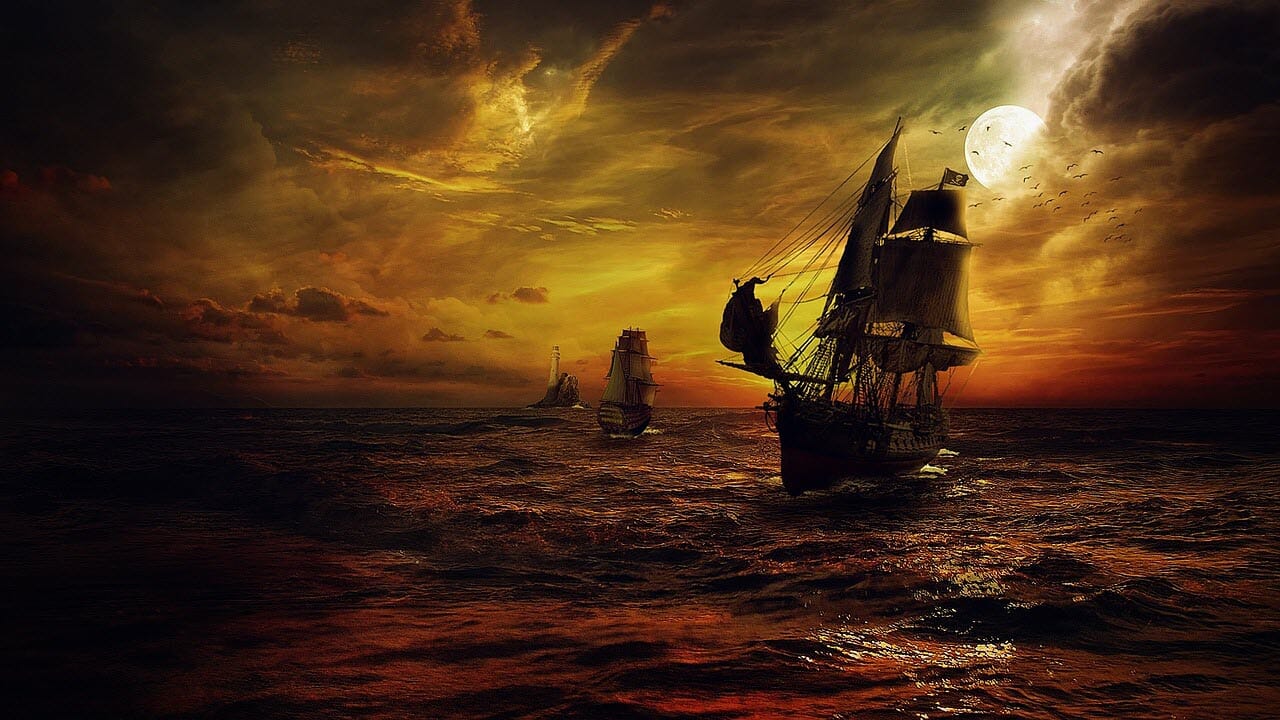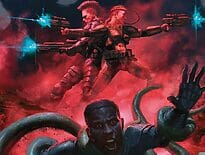Pirate Borg invites the players to play grog-willing pirates who face undead galleons, find arcane treasures in ancient temples, and find high seas adventure. The core rulebook has everything a GM needs to create a Dark Caribbean world of pirates and undead.

My thanks to Free League for sending me a copy of Pirate Borg to assist in my continuing coverage of their RPGs. Previous articles have covered The One Ring extensively and other Free League RPGs like the Forbidden Lands.
Rules
The character sheet in the back is innovative. It includes character creation rules with check boxes. As a character is created the boxes are checked and once done the character sheet is filled out without missing and details. I like this implementation quite a bit.
The basics are roll a d20 and meet or beat a difficulty class. The players roll both attack and defense so NPCs and monsters do not roll. Personal combat has decent detail and blackpowder weapons are included. There is also an in depth naval combat section including cannons and a large selection of sailing ships.
What the Pirate PCs Do
As pirates, they search for treasure, take on odd jobs, and attempt to gain a ship or improve one they already have. There are two pages for GMs to generate ships at sea, ships that carry cargo worth money and/or include important NPCs. The PCs try to avoid getting robbed, shanghaied, arrested and then hung, attacked by undead (at least undead they can’t defeat without too much harm), and other unpleasant fates.
Who the Pirate PCs are
Landlubbers have no class and rely on raw ability. There are six regular classes to choose from as well and two optional classes. For example, the brute is a fighter with abilities that range from grog breath to a boomstick. The buccaneer is basically a ranger with focused aim and survivalist. PCs can also be rapscallions, buccaneers, swashbucklers, zealots, and sorcerers. The two optional classes are the haunted soul, basically a ghost, and a tall tale—either something from the water like a merfolk or a sentient animal.
In addition to abilities and features, each PC gets random clothing, a weapon, and a hat like an old uniform, cutless, and a plain tricorn. PCs add in a random container and one each of cheap gear and fancy gear like a large sea chest, lantern, and spyglass. They get a number of the Devil’s Luck which can turn fate their way in a variety of ways. The PC is then ready to go.
PCs also have access to ancient relics (magic items) and arcane rituals (spells). As a group, they can also try to sing sea shanties well for a mechanical benefit.
Support for the GM
Pirate Borg is packed with support for the GM: random tables, history of the Dark Caribbean, nation information, a complete settlement, and a full adventure. Random tables range from NPC motivation to loot the body to the current ash (undead drug) market. For ship encounters, there is a d20 table which includes results like the Kraken, navy ship of the line, and a blood drenched ship of the dead.
Imperialism is dying in the Dark Caribbean. The Republic of Pirates is rising and raging against law, order, and responsibility. Remnants of British, French, and Spanish power can still be dangerous, however as can evil in the Yucatan. A GM building a world could pick one of these three powers to be the major nemesis for the pirate PCs.
Or, go old school. Cultists are trying to bring about the end of days. Their prophet, the Sunken One, brings omens from the Great Old Ones and put these dark psalms into Necromomicon. A great idea would be to present one of the former Imperial powers as the main villain, then reveal that cultists have infiltrated not just this power but maybe every major power in the Dark Caribbean. A chilling discovery that would launch a whole new series of adventures.
GMs have a variety of foes to pull from. There are dark animals and birds, aquatic monsters like deep ones and undead megalodons, hungry plants, skeletons, zombies, and ghosts. There are tables to create NPCs along with four statted out NPCs including the inquisitor and the necromancer. These NPCs could be the villainous focus of an entire campaign.
Other tools include a treasure map generator, uncharted islands, and job and quests. With these tools, a GM can create their own world and fill it with places to adventure and quests for PCs to pursue.
For GMs in a time crunch, The Curse of Skeleton Point is a combo hex crawl, dungeon, and settlement already ready to go. A GM could kick off a campaign here, bring PCs in after a few other adventures, or pull maps and NPCs and encounters out to use in other adventures. Skeleton Point is interesting in particular because of a wrecked ship perched on top of a tower after a hurricane. It is filled with treasure but getting it out without tipping the whole ship over is tricky.
There are also plot hooks, complete dungeons including a lighthouse and Carcass Beach, and a variety of locations to visit and NPCs to interact with. There is a nearby jungle with more the map and all descriptions together to cut on page flipping.
Should You Get?
If you like pirate PCs, undead, and Mythos horror using familiar d20 rules with a twist, then yes. I see this RPG as easier to run (and likely to interest more players) than Mork Borg. The book is beautiful it is also more user friendly on the eyes and looks designed to actually be played and used at the game table. Even if you never intend to run Pirate Borg, the maps and adventures and NPCs are useful. And if you ever need a quick pick up RPG, the easy character creation and ready to go GM support has you covered.
Picture credit: Pixabay

